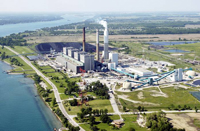Ontario nearly coal-free
In 2003, Ontario's government made a decision to stop burning coal. Since that time, Ontario has cut its use of coal by nearly 90 percent, and more than 80 percent of its power generation comes from water, nuclear, and renewables.
 |
|
Lambton generating station |
The last of Ontario's coal plant operations will cease by the end of 2013 -- a year earlier than originally planned. In 2014, Ontario's use of coal is expected to be less than 1 percent of total electricity generation -- down from 25 percent in 2003.
Ontario's two largest coal-fired electricity plants, Nanticoke and Lambton, will close early as a result of the province's improved electricity grid, increased efficiency, strong conservation efforts, and diversified supply of clean energy -- effectively shutting down 17 of the Province's 19 coal plants.
Ontario currently uses less coal-fired generation in its energy mix than any G8 nation and has been none the worse for wear. Clean energy and a modern electricity system have created tens of thousands of jobs and attracted investors and a high-quality workforce. In 2012, the renewable energy sector saw $12 billion in capital investment.
In fact, in 2011, Ontario was the world's leading region for renewable energy projects, according to the Financial Times' fDi Intelligence think-tank.
By the end of 2014, Ontario will be one of the few places in the world to eliminate coal as a source of electricity production.
For more:
- see this
article